PDM II - Now Available!
As of January 2022, PDM has moved into a legacy product status and is no longer shipping.
Its successor, PDM II, is available for all your program delay needs.
Program Delay Manager Overview {Legacy Product}
PDM Features
-
PD Alert™ instantly emails time-stamped audio files whenever Dump is pressed
-
Files capture what took place both on- and off-air
-
Seamlessly builds and exits delay
-
Configurable delay time, build and dump options
-
Delayed IP data, serial streams and GPIO sync’d to audio
It’s About Time
Leave it to 25-Seven® Systems to re-invent the profanity delay. Program Delay Manager (PDM) brings the possibilities of the Internet age to a “stand-alone box” technology that hasn’t advanced much since the 1980’s. Ease of use, transparent audio quality and program director friendly features converge in PDM to take an old process to a new level.
The Air Check is in the Email
Program Directors have more on their plates today than ever before. There’s no way anyone can monitor every broadcast hour of every day, but PDs need to be the first to know what happened when that “dump” button got pressed.
With Program Delay Manager’s patented PD-Alert™ feature, two time-stamped audio files capturing what took place both on air and off air get internally archived and emailed to the PD (or GM, or CE, or the legal team) every time questionable material is “dumped”.
For stations serious about protecting their license, PDM provides an instant log record establishing your station’s action and intent to keep the airwaves clean.
99 Seconds Of Delay Your Way
PDM comes standard with 99 seconds of stereo audio delay, and a dump button that can be set to remove any number of seconds you choose.
Build a delay through pre-rolling, time expansion or audio file play-out capabilities built right into PDM. Exit a delay through time compression or use the Cough button to simply wait and exit.
Dump audio through the standard “cut and rebuild” method, or use PDM’s Overkill™ feature to play a “fill” file. Overkill allows you to select a show specific file from a list and play it over the dump buffer instead of collapsing the delay.
Program Delay Manager Features {Legacy Product}
How PDM Does It
Superior Audio Algorithm Quality
25-Seven has a well-deserved reputation for offering the industry’s most transparent time compression and expansion algorithms. Your listeners probably won’t appreciate our superior, artifact-free audio because they won’t perceive it’s in use!
Flawless Expansion/Compression
25-Seven Systems’ imperceptible audio time compression algorithms serve up smooth, crisp, stutter- free audio in PDM, even on stereo music. Unlike other products, we never splice at level thresholds or alter pitch. Clean audio is what we do best… now you can be sure the content is “clean” as well! Better algorithms mean delays can be rebuilt faster, so you can safely get back to callers. Build or Exit rates can be adjusted in real time, so you can be more or less aggressive, depending on audio content.
Audio, RDS, Data Streams and GPI/O Stay Synced
PAD or “now playing” data streams are delayed in precise synchronization with the audio as it grows, shrinks or whenever the dump button is pressed. PDM’s data-follow-audio capabilities allow flexible synchronization from any data input to any data output. For example, serial data entering the RS-232 input can be routed to an IP output while remaining synchronized to the audio. 2 independent data delays are supported, and GPI/O closures stay in sync, too.
Future-Proof Audio Quality
Superior balanced analog I/O, with AES digital standard. 85dB s/n, response 25Hz-18kHz (+0/-0.2dB) and 0.02% THD+N… even during compression/expansion. Audio is always linear, so no lossy data reduction enters your signal path.
AES Digital, Balanced Analog or Livewire® AoIP
The first program delay to provide Audio over IP (AoIP) and control over Axia® Livewire audio networks, PDM comes in two models: one with balanced analog and AES digital I/O and the other with AoIP for Livewire. Whether you already have a Livewire network or you want to keep your plant AoIP-capable, PDM has you covered with Ethernet connectivity.
Superior Control
Choices, choices! PDM presents you with easy-to-use front panel controls, designed for the rigors of radio. Contact closure commands can be synced to the audio delay by the smart, programmable 8x8 GP I/O. Full bi-directional serial control over both RS232 and IP include advanced real-time status monitoring of parameters such as current delay depth and audio levels. A comprehensive web interface allows your PDM to be managed from nearly anywhere. Our Multi-View web feature permits networks and big facilities to monitor and manage up to 20 PDM’s from a single browser screen.
Web Configurable
Say goodbye to hieroglyphs. Navigating through “set and forget” parameters is a breeze with our built-in web server. Change your settings, upload audio files and manage PDM’s dump archives using simple browser screens, so you don’t waste time trying to enter data though an ill suited LCD interface. Talk to PDM over your LAN or WAN. What could be easier?
Program Delay Manager In Depth {Legacy Product}
Web Interface
In addition to controlling Program Delay Manager using GPIO (contract closures), PDM comes with a built-in, password-protected web server, allowing you to remote control your unit across a local or wide area network. The server gives you five separate pages for complete and convenient control over your PDM
Front Panel
An Adobe Flash-based application replicates PDM’s front panel on your web browser, so every button and display is present and functions just like the real front panel. Through careful client-server communications management, round-trip latency is almost imperceptible, creating a seamless user experience. You can even control PDM from multiple computers. Just open a web browser interface on each, and anything you do on one computer will be reflected on the others, as well as on PDM’s physical front panel.
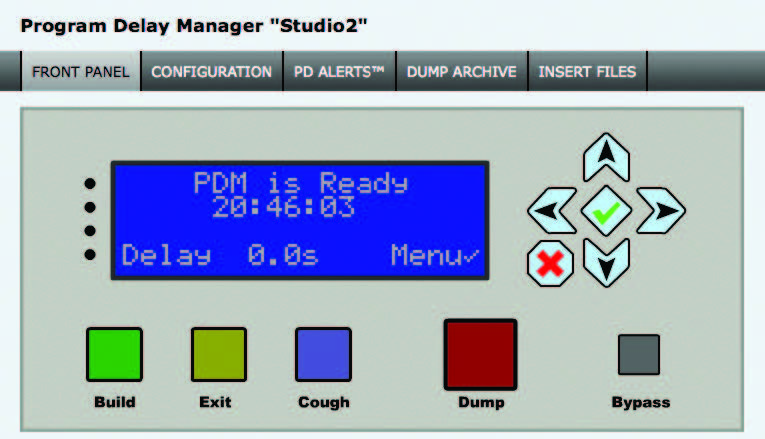
Configuration
Tired of learning hieroglyphics just to configure a profanity delay? Navigating though “set and forget” parameters is a breeze with the PDM’s Configuration page. You’ll find obvious control with all your settings on one simple screen, so you don’t waste time entering data though an ill-suited LCD interface.
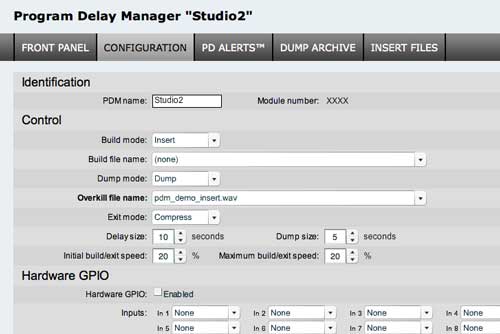
PD Alerts™
A dedicated page lists all of the PD Alert emails the PDM has sent to your chosen staff.
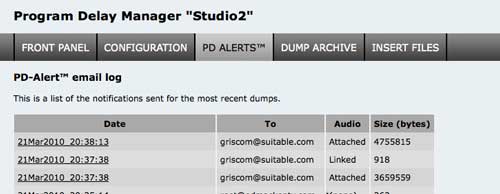
Dump Archive
A Dump Archive shows all your saved dumped audio files. Easily review just what’s been cut out of your air stream.
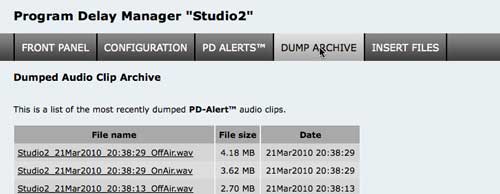
Insert Files
Easy management of the files you can use for quickly building your buffer at the beginning of the show. No more flash drives and cryptic file names!
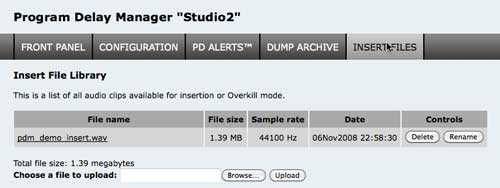
Program Delay Manager Specifications {Legacy Product}
Power Input
PDM comes with a standard IEC C14 power connector.
Network
PDM connects to a standard 100BASE-T network connection. This port is used for Axia Livewire, synchronization to a network time server, and secure remote control via a web browser. If connected to the Internet, it should be behind a hardware firewall.
Analog Inputs and Outputs
Stereo inputs are electronically balanced XLR females, pin 2 hot, with a load of 20kΩ: this makes it compatible with all modern electronically-balanced outputs. If fed from a transformer-balanced output, we recommend bridging a 680Ω resistor between pins 2 and 3. Outputs are electronically balanced XLR males, pin 2 hot, designed to feed a load of 600Ω or greater. Input and output sensitivity default levels can be set from the front panel, and can range between +20dBu and -10dBu.
Digital Inputs and Outputs
When set to AES/EBU via the configuration menu, this input conforms to IEC 958 Professional (5v p-p, 110Ω balanced) on XLR connectors. When set to s/pdif, the voltage and impedance switches to IEC 958 Consumer (.5v p-p, 75Ω unbalanced): connect signal to pin 2 and shield to pins 1 and 3. Digital output (selectable AES or s/pdif) is always active, regardless of whether you are using analog or digital inputs. PDM will lock to any valid 32 kHz, 44.1 kHz, or 48 kHz signal at the digital input connector, even if you have selected analog for the input. In that case, the digital input controls PDM’s internal sample rate. If PDM is not connected to a digital input, it uses its own high-reliability 44.1 kHz sample clock
Axia Livewire Version Inputs and Outputs
On the Livewire version of PDM, audio connections are exclusively via the network. PDM-Axia also supports Livewire-based GPIO.
GPIO
Eight parallel control inputs and eight parallel control outputs appear on a DB-25 connector. Input and output functions are assigned through a configuration menu on the front panel. Inputs and outputs are opto-isolated for easy interface to other equipment. A +5v supply and ground are also brought out to the DB-25 for simple remote controls using pushbuttons and LED status readouts. The +5v supply can carry 200 mA, more than adequate for 8 LEDs and 8 logic inputs. It is protected by an internal, self-resetting thermal circuit breaker.
Detailed Specifications
Audio
- S/N ≥ 84 dBA with 10 dB headroom (≥94 dB dynamic range); THD @1 kHz < .01%; IMD (IHF) < .01%;
Frequency response ± 0.5 dB, 20 Hz – 20 kHz, measured analog input to analog output.
Dimensions
- 1RU (rack unit); 19” W (with rack ears) x 12” D x 1.75” H (483 x 305 x 44mm)
Power
- 100-240 VAC, 50/60 Hz; typical consumption 32 VA.
Regulatory
North America: FCC compliant, power supply is UL approved.
Europe: Complies with the European Union Directive 2002/95/EC on the restriction of the use of certain hazardous substances in electrical and electronic equipment (RoHS), as amended by Commission Decisions 2005/618/EC, 2005/717/ EC, 2005/747/EC (RoHS Directive), and WEEE.







